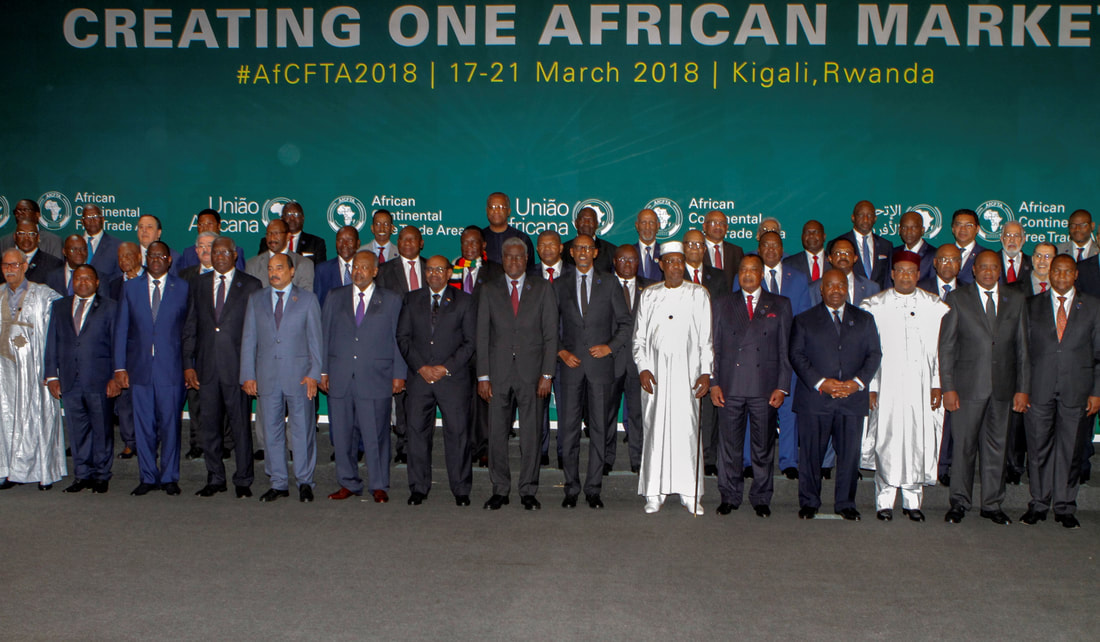What does this mean for the continent and for US SMEs interested in trade opportunities with countries in AfricaThe African Continental Free Trade Agreement (AfCFTA), is set to enter into force on 30 May 2019, given that half of the original signatory countries have completed ratification of the agreement[1]. The AfCFTA was first conceived by the 55 members of the African Union as a step towards an African free trade area to promote intra-African trade for sustainable economic development and integration into the global economy[2]. The first round of AfCFTA negotiations was held in February 2016, and the final text was signed by 44 countries in Rwanda on 21 March 2018. Eight more countries have since signed the deal. Only 3 countries of the African Union (Benin, Eritrea, and Nigeria), have not yet signed on to the AfCFTA. With the ultimate aim of the single market, the AfCFTA paves the way for a continental wide customs union in the near future that integrates the many existing regional customs unions throughout Africa already in place.[3] The AfCFTA will cover an economy with more than one billion of population and a GDP of $2.5 trillion in the region. The AfCFTA will facilitate intra-trade within the region, supporting SMEs with tariff reductions and elimination of trade barriers. Intra-African trade is estimated to increase by 52% by removing import tariffs and expected to double if non-tariff barriers are further removed, according to the UN Economic Commission on Africa[4]. African countries are ready to reap the economic benefits resulting from the AfCFTA.
It is hoped that a more integrated economy throughout Africa will also have other tangible benefits for those that want to trade with Africa. With the AfCFTA coming into force, American businesses are likely to benefit from the continent’s economic integration. Through the enhanced trade facilitation measures, it will be easier for African businesses to source products within the region and therefore reduce operational costs, as well as increase the efficiency of customs procedures[5]. Increased efficiencies, improved logistics, and elimination of intra-trade barriers will help expand US market access into and throughout Africa. Opportunities for US SMEs Africa presents many opportunities for US businesses. The United States had a total trade of goods at $24.9 billion in 2017 with the 49 Sub-Saharan African countries. US goods exports totaled $14.1 billion[6], and in 2017, the top US export categories to the region were machinery, vehicles, and aircraft. Top imports from the continent were mineral fuels, metal and stone, and cocoa. The United States has several programs in place to support trade between the United States and African countries. AGOA and GSP for imports from developing countries To support trade and economic development in the region, the African Growth and Opportunity Act (AGOA) and the Generalized System of Preferences are two US programs that provide trade and tariff preferences for imports from the region since 2000[7]. Under AGOA alone, more than 5,200 tariff lines are duty-free into the United States from 34 AGOA countries if wholly obtained or sufficiently manufactured in the region[8]. These two programs have helped African economies to grow, as well as provide important sourcing opportunities for US businesses. Export Credit Guarantee Program In addition, the US Export Credit Guarantee Program encourages US businesses to export agricultural commodities to the region by reducing financial risk to lenders[9]. As the United States is the largest exporter of agricultural products in the world, this program has supported not only US exporters with more sales opportunities, but also African economies for a continuous supply of agricultural commodities. Although a few African trade blocs, such as Economic Community of West African States (ECOWAS), Southern African Customs Union (SACU), and others, have made some progress integrating its trading system, the existing institutions continue to face hurdles enforcing new rules, given Africa’s fragmented market. With the trade facilitation measures included in the AfCFTA and the support from the UNCTAD and the WTO, it is hoped that the AfCFTA, once in force, can effectively unify the African market, facilitate intra-African trade, and strengthen the continent’s economic development through improving the ease of doing business. We would love to hear from you. Send us your thoughts on the AfCFTA or other opportunities for US exporters on our LinkedIn or Twitter. Chinyen Cheng [email protected] (+1) 240.389.9003 [1] AfCFTA Agreement secures minimum threshold of 22 ratification as Sierra Leone and the Saharawi Republic deposit instruments, African Union Press Release, 29 April 2019. [2]A Business Guide to the African Continental Free Trade Area Agreement, International Trade Center, page 13, 2018. [3] About us, African Union website [4] Africa’s big new free trade agreement, explained, Washington Post, 29 March 2018 [5] Who are the winners and losers in Africa’s Continental Free Trade area? World Economic Forum, 17 October 2018 [6] Africa - Region Introduction, USTR [7] Issue area - AGOA, USTR [8] Trade Agreement - AGOA, US CBP [9] Agricultural Export Financing, Country Commercial Guide Comments are closed.
|
|





